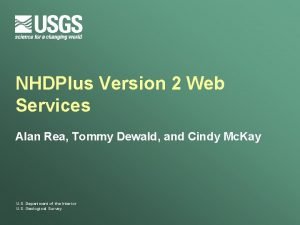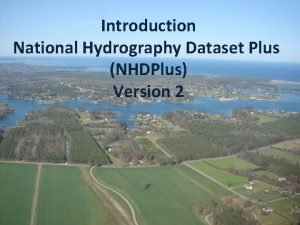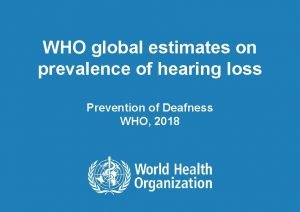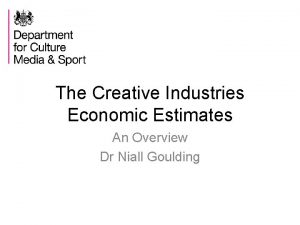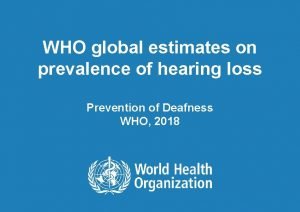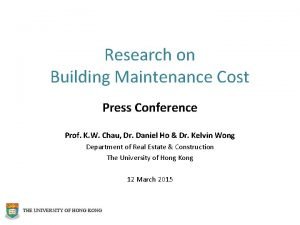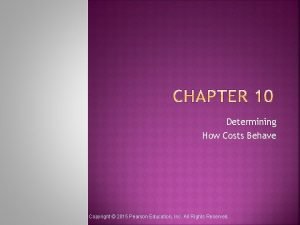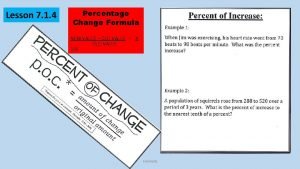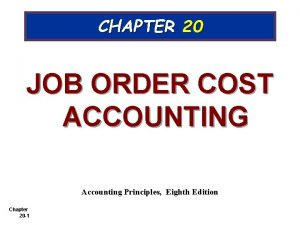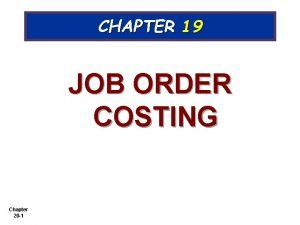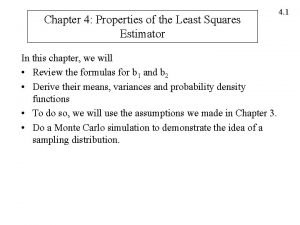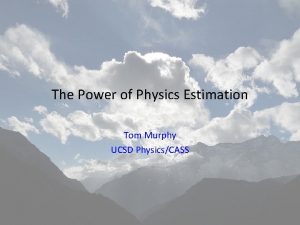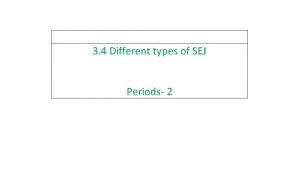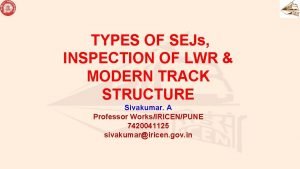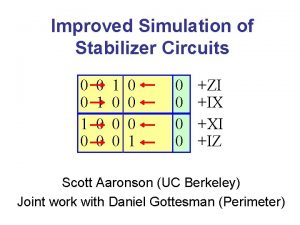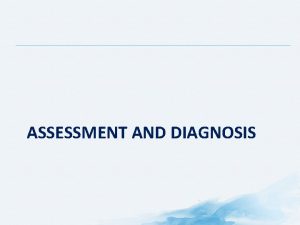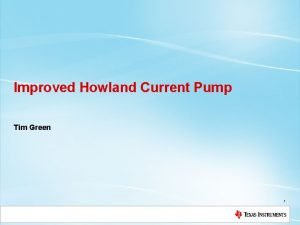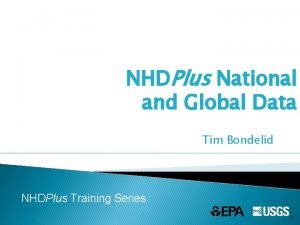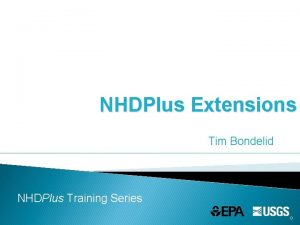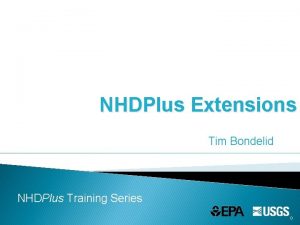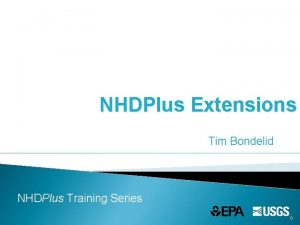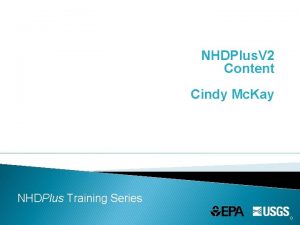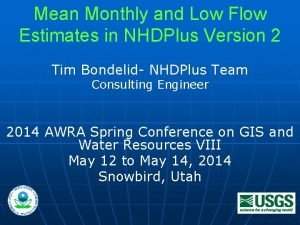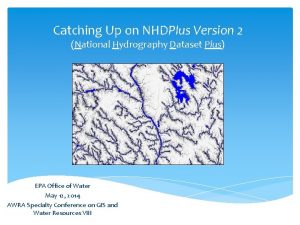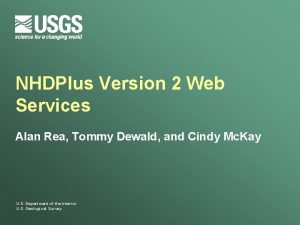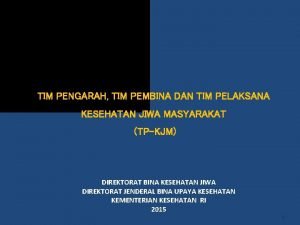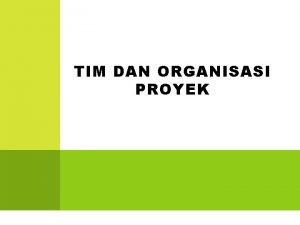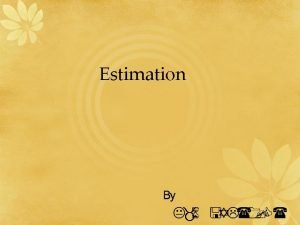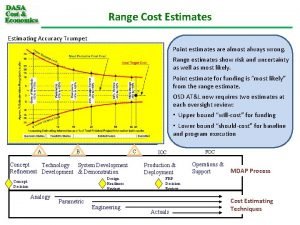Improved Flow Estimates in NHDPlus Version 02 Tim


















- Slides: 18

Improved Flow Estimates in NHDPlus Version 02 Tim Bondelid- NHDPlus Team Consulting Engineer 2012 ESRI International User Conference July 23 -27, 2012 San Diego, CA 1

NHDPlus V 02 Enhanced Runoff Method (EROM) Contributors: • The NHDPlus Team • EROM: Dave Wolock, USGS n Kernell Ries, USGS n Greg Schwarz, USGS n 2

Importance of Stream Flow Estimates n n Support the water element goals expressed in the EPA Strategic Plan Support the water mission of the USGS • Water-quality modeling (SPARROW) • Regional and national stream flow assessments goal of National Stream Flow Information Program • National Water Census n Watershed planning and management 3

NHDPlus Version 02 Flow Estimation • Enhanced Runoff Method (EROM) n Mean annual and mean monthly flow estimates • Current V 02 release is mean annual flow Significantly improved ingredient data n Five-step process n • Each step incrementally improves the flow estimates n Flow QA module; statistics on performance 4

5 U. S. : Wolock and Mc. Cabe; CN and MX: Canadian Forest Service

Step 1: Runoff (SR) Gage Mean 2. 36 QA Statistics Runoff EET Ref Reg. Plus. Flow Mean SEE 2. 17 58. 8 2. 37 32. 6 Gage Seq. SEE 6 23. 0

Step 2: Excess Evapotranspiration (EET) Method developed by Dave Wolock of USGS. (graphic courtesy of Dave Wolock) 7 7

Step 2: EET (10 L) Gage Mean 2. 35 QA Statistics Runoff EET Ref Reg. Plus. Flow Mean SEE 2. 46 118. 7 2. 30 90. 6 2. 37 32. 6 Gage Seq. SEE 8 23. 0

Step 1: Runoff (SR) Gage Mean 2. 36 QA Statistics Runoff EET Ref Reg. Plus. Flow Mean SEE 2. 17 58. 8 2. 37 32. 6 Gage Seq. SEE 9 23. 0

Step 3: Reference Gage Regression (SR) Gage Mean 2. 36 QA Statistics Runoff EET Ref Reg. Plus. Flow Mean SEE 2. 17 58. 8 2. 37 32. 6 Gage Seq. SEE 10 23. 0

Step 4: Transfer, Withdraw, Augment Flows (“Plus. Flow. AR”). 3 2 1 4 6 Transfer 2 cfs 7 9 . 5 8 10 . 5 2. 5 12 11

Step 4: “Plus. Flow. AR” (NE) Gage Mean 2. 42 QA Statistics Runoff EET Ref Reg. Plus. Flow Mean SEE 2. 40 14. 9 2. 43 14. 7 2. 43 11. 7 Gage Seq. SEE 12 10. 9

Step 5: Gage Adjustment. 3 2 Flowline adjustments closest to the gage will get higher weights than Flowlines farther from the gage 1 . 5 9 10 Gage DA = 12 Gage Q = 13 EROM Flow = 12 QAdj = 13 – 12 = 1 6 . 5 12 13

Gage Adjustment: Re-Accumulated Flows. 3 2 1 . 5 6. 16 9. 40. 5 10. 67 Gage DA = 12 Gage Q = 13 Flowline Flow = 12 QAdj = 13 – 12 = 1 13 14

Gage Adjustment QA: n Randomly remove 20% of the gages from the gage adjustment • Called “Gage Sequestration” n Gage Mean 2. 36 Provides a ballpark estimate of how well the final, gage-adjusted flows match gage flows QA Statistics Runoff EET Ref Reg. Plus. Flow Mean SEE 2. 17 58. 8 2. 37 32. 6 Gage Seq. SEE 15 23. 0

EROM – Next Steps n We are always looking for ways to improve EROM • Reference Gage Regression; issue with cases where it “over-adjusts” at higher flows • Increase the number of gages; the more valid gages the better! • Update to a more recent version of Reference Gages; “GAGESII”? • Adjust flows further upstream? • Monthly flows 16

Down the Road n Plus. Flow. AR: • Incorporate more detailed information from NHD Stewards, WBD, others! • Seasonal values? n n n EET Step: Model Coefficients, issues in some areas Other flows: 7 Q 10 Use a 1981 -2010 time frame • PRISM has released “normals” for this period • The major issue: international drainage 17

Questions? Tim Bondelid - Independent Consultant to EPA timothy@trbondelid. com NHDPlus V 02: http: //www. horizon-systems. com/NHDPlus 18
 Nhdplus version 2
Nhdplus version 2 Nhdplus version 2
Nhdplus version 2 Who global estimates on prevalence of hearing loss 2020
Who global estimates on prevalence of hearing loss 2020 Creative industries economic estimates
Creative industries economic estimates The fermi problem
The fermi problem Who global estimates on prevalence of hearing loss 2020
Who global estimates on prevalence of hearing loss 2020 Building maintenance cost estimates
Building maintenance cost estimates The account analysis method estimates cost functions
The account analysis method estimates cost functions Eva estimates that 475 songs
Eva estimates that 475 songs Marquis company estimates that annual manufacturing
Marquis company estimates that annual manufacturing Marquis company estimates that annual manufacturing
Marquis company estimates that annual manufacturing Least square property
Least square property Fermi problem
Fermi problem Sej in railway
Sej in railway Improved sej drawing 6922
Improved sej drawing 6922 Improved simulation of stabilizer circuits
Improved simulation of stabilizer circuits If you can’t measure it, you can’t improve it.
If you can’t measure it, you can’t improve it. Snoop headache criteria
Snoop headache criteria Improved howland current pump
Improved howland current pump
